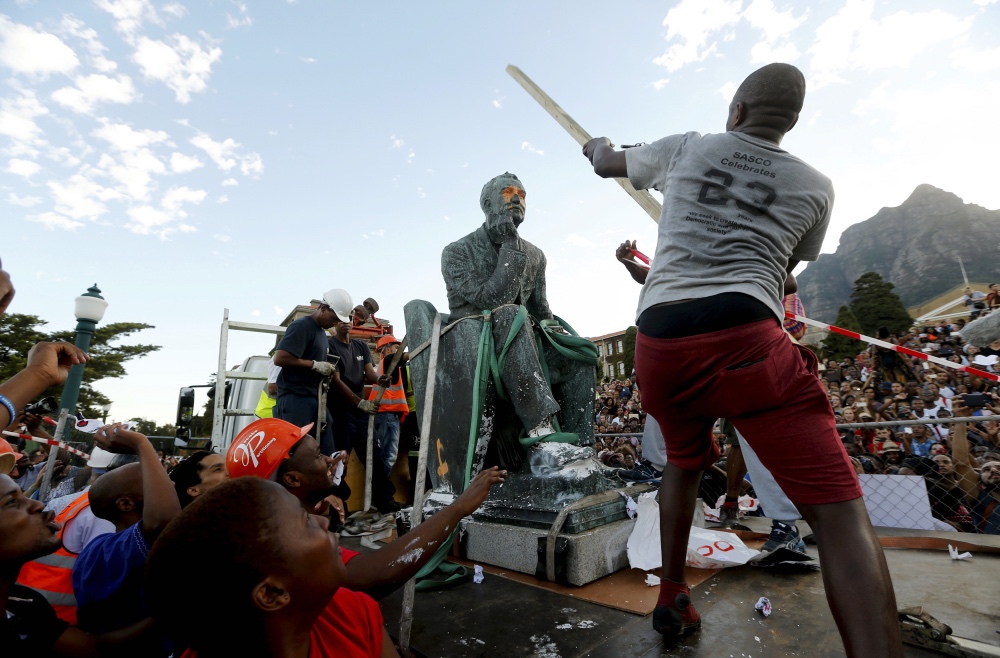Nairobi, Kenya
Thomson Reuters Foundation
Countries must find more creative ways to depict their history than statues that glorify racists and colonialists, a founder of South Africa’s successful Rhodes Must Fall movement said on Thursday.
A wave of anti-racism protests sweeping across the United States and Europe has reignited debate about monuments that glorify countries’ imperialist pasts, which many people see as offensive in today’s multi-ethnic society.

A student beats the statue of Cecil John Rhodes with a stick as it is removed from the University of Cape Town (UCT), on 9th April, 2015. The statue at the university, one of Africa’s top academic institutions, has been covered up for the past few weeks as both white and black students regularly marched past with #Rhodesmustfall placards calling for its removal. They believe it is a symbol of the racism against blacks that prevails in South Africa two decades after the end of oppressive white-minority rule. PICTURE: Reuters/Mike Hutchings/File photo.
Statues linked to colonialism and slavery have been defaced or pulled down in the United States, Britain and Belgium amid protests sparked by the death of George Floyd, a black man, after a policeman knelt on his neck for almost nine minutes.
Ramabani Mahapa, who served as president of the University of Cape Town Students Representative Council and led a 2015 campaign to remove a statue of imperialist tycoon Cecil Rhodes, said he was encouraged by the movements across the world.
“We’ve got to find different ways of educating the public about our history. I don’t think these statues are the right way to go about it – especially given that many of them are about glorifying oppression and racism,” said Mahapa, 28.
“The goal when they were erected was a testament to the attitudes towards race at the time. As the current generation, we have different attitudes and the continued presence of these monuments is problematic.”
A mining magnate, Rhodes was a central figure in Britain’s colonial project in southern Africa, giving his name to Rhodesia, present-day Zimbabwe, and founding the De Beers diamond empire.
He made his fortune from the exploitation of African miners, secured power through bloody imperial wars and paved the way to apartheid with his beliefs and measures on racial segregation.
“Sense of loss”
In March 2015, Mahapa led hundreds of students at the University of Cape Town in the #RhodesMustFall protests to remove the statue from the entrance steps to the university.
Students said it glorified a man seen by many as an architect of apartheid, and that the university campus should be more representative of South Africa’s diverse history and culture.
“The statue had a very prominent position right at the entrance to the university. You couldn’t even take a picture properly of the university with the backdrop of the Table Mountain because of the statue,” said Mahapa.
“When I looked at it, I felt a sense of loss. I felt a sense of displacement. The statue was telling me that I didn’t belong there.”
After over a month of protests, university authorities relented and the statue was removed – but not before inspiring a similar movement by Oxford University students, which has been reinvigorated by the current global protests against racism.
In recent days, monuments of British slave traders Robert Milligan and Edward Colston, Belgian’s King Leopold II, explorer Christopher Columbus and confederate leaders such as Jefferson Davis have been torn down by protestors or authorities.
Mahapa said changing the wording on plaques of monuments to provide historical context and background, as some supporters of the monuments have suggested, was not the solution.
“There may be other creative ways that these statues could be put on display for public education purposes. I think placing them in museums with appropriate contextual background would be appropriate,” said Mahapa.
“Or even relocating them to less prominent places within a city or university may also be appropriate depending on the context and the outcome of the public participation process.”
Mahapa, now a researcher with the Land and Accountability Research Centre in the Department of Public Law at the University of Cape Town, says the statue’s removal has led to more conversation amongst students about racial injustice.
But, he added, much more needs to be done.
“If you go around Cape Town university today, it is still full of colonial iconography. There are plaques and pictures of old white men who are benefactors or ministers of education from the apartheid era everywhere.”
“There is nothing really African here that we can identify with. There is nothing that says ‘Black child you belong here'”.






